

Xavier Bick - NanoJapan 2013
University of Dallas
Major/s: Physics
Anticipated Graduation: May 2016
NJ Research Lab: Arikawa/Tanaka Lab, Kyoto University
NJ Research Project Poster:High-Sensitivity Room Temperature THz Sensor Based On Impact Ionization
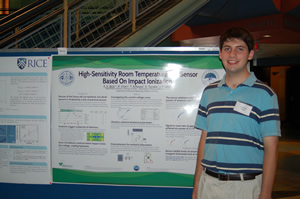
Why NanoJapan?
Although there are many opportunities to do research in the United States, international research programs like NanoJapan provide students a research experience that more fully prepares them for life after school. Study abroad programs like these help to develop participants communication skills and enhance their understanding of other cultures so that they can work unhindered in an international economy. NanoJapan is particularly important because it not only gives students the opportunity to study terahertz radiation and nanotechnology with leaders in the field, but also that it does so through some of the best universities in all of Asia.
I applied for NanoJapan for precisely these reasons. Technology employing terahertz radiation is becoming more and more prominent. As research like that done in NanoJapan improves the reliability of such technology, it will start to appear in many more fields and devices. I am looking forward to being able to witness this research and contribute to it myself, and I am very excited to have this chance to study in Japan and to learn Japanese.
My goals for this summer are to:
As of now, I REALLY like Japan. Tokyo is awesome, everything is very clean, organized, and efficient, despite its crowdedness. I like how each district of Tokyo has its own distinct "flavor". I also like being able to walk or take the subway to anywhere in the city. One thing I thought was very similar to my expectations was Akihabara. What I imagined Tokyo to be like was exactly what Akihabara was like. On the other hand, Asakusa during the festival was rather different than what I thought a festival in Japan would be like. Some things I had expected, like the carnival-style game stands, the tourist shops, and the novelty food items such as chocolate covered bananas and the pikachushaped donuts. Other things I had not thought about. For example, I knew that the festival was religious, but I did not anticipate the extent to which people participated in the ceremonies.
I love learning Japanese. It's such an interesting language, and the more time I spend with it, the more fascinating it becomes. The classes are very intense. I like the pace, but I wish we had more time in the afternoon to study the language. Of the 5 languages I have formally studied, Japanese is by far most difficult. More difficult than Greek or Chinese. It takes a long time to become good at reading kana quickly, plus there's the kanji. Because of the mix of kana and kanji, the changes in pronunciation, and the general structure of the Japanese language I think that learning the kanji is far more complex and difficult than learning the Chinese hanzi. However, after today's class it seems that it may be getting slightly easier as I get used to the nuances of the language. I have had many opportunities to use what I have learned in class. It seems that every day after class I immediately use what I have learned either in talking with friends, shopping and going to restaurants, and reading signs or hearing people speak.
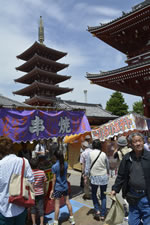
From a festival at Asakusa's Sensoji temple. I like this photo because it shows how large and impressive the temples are but it also highlights the atmosphere of Japanese festivals.
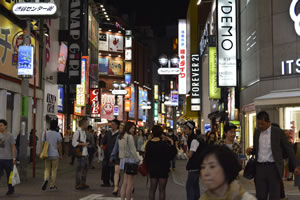
Saturday night in Shibuya. This photo is also a good representation of the fashion and variety of clothes people wear in Japan, barring the most extreme styles.
On the subway, it seems that most people sit if there is an open seat, but if they are only on for one or two stops then some people just stand. When there is no room to sit, people stand near the doors that won’t open at the next stop so that they don’t get in the way of people who are trying to get on or off. There are “courtesy seats” on the front end of each car, but everyone sits there anyway if there is room. I’ve only seen one person let someone else have their seat in that section, but most of the time you don’t see people on the subway who use the courtesy seats were intended for (elderly, injured, small children, etc.). I would say that about half of everybody who stands doesn’t use the handles. When it’s crowded, I’ve noticed that most of the guys cross their arms. Kono-sensei told us that it’s because there have been a lot of cases of false accusations of sexual harassment, so if you cross your arms then it’s harder for people to suspect you of anything. It also makes people feel more comfortable since they can see where your hands are.
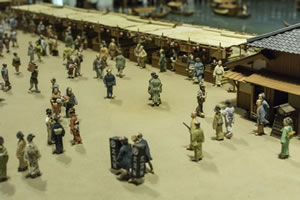
A model of everyday life in early Tokyo, from the Edo-Tokyo Museum.
Silence seems to be highly valued. Most people consider it rude to talk on your cell phone. Once, Packard-sensei got a phone call on the subway and she told the caller that she couldn’t talk because she was on the subway. There is even a section of the car where talking on your cell phone is prohibited. On the DART (Dallas Area Rapid Transit) Rail, you rarely see people next to another person, they would stand instead. On the subway/metro/JR lines in Japan, people won’t hesitate to sit next to a complete stranger. I think this may be due to the seat orientation, but it probably also has to do with differences in notions of personal space. People also seem to prioritize being out of the way of people getting on and off the train than giving each other the maximum amount of personal space possible. For example, if someone is standing on the opposite doors from the ones that open, and another person gets on, that person will stand next to the first person rather than across the car from him because he wouldn’t want to get in the way of people going through the door.
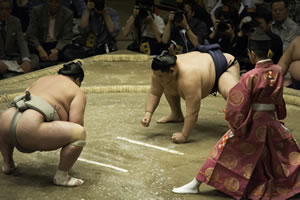
This Saturday, we went to watch Sumo wrestling with Packard-sensei and some of the AJALT instructors.
As I look towards the end of the orientation period and moving into the research internship, I am most excited about being able to live in Kyoto for two months. I’m really looking forward to visiting the temples and going to an obscure tea shop. I’m most nervous about getting to know the other members of my host lab because I’m worried I’ll make a cultural mistake on the first day or introduce myself improperly and leave a bad first impression.

The Gundam Café in Akihabara, where all the food is designed to look like something from the anime.
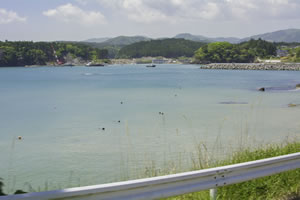
After language classes on Thursday, we took the Shinkansen to Sendai. Friday morning, we left on a bus to Minamisanriku. I expected to scenery on the way down to be nice, but I had not expected it to be like how it was; the valleys and mountains were much larger than how I thought they would be. The first thing we did when we arrived in Minamisanriku was stop at a small shopping area to buy ice cream. In the shop that sold the ice scream, I found lots of different kinds of fresh fish for sale, reminding me the Minamisanriku’s chief export is fish, and that they are still trying to be competitive in that market. At a store next to the fish and ice cream shop (although they didn’t sell fish ice cream) I bought an Utatsu t-shirt (Utatsu is the eastern part of Minamisanriku, and some consider it to be a separate city). It had some kanji on it that meant “inter-people collaboration”. Packard-sensei had to ask the cashier what it meant because of the differences in their dialect. That was the first time I had experienced any differences from Tokyo dialect.
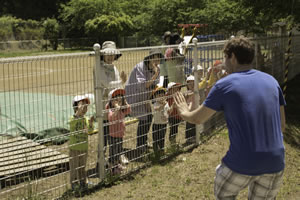
After that, we went to the kindergarten. It was nicer than I thought. From the kindergarten we went to Lawson konbini to get lunch, which we ate at the beach. The beach was peaceful, but there was still some debris on the shore. When we were finished with lunch, we went to the elementary school. It was much nicer than I thought it would be. In some respects, it was nicer than my own elementary school. We had a “scientific” activity prepared for the students: they were supposed to use chopsticks and tape to construct a weight-bearing bridge across a 50cm gap. We split up into two groups, 5th and 6th grade. From there, we paired up one NJ and on KIP student and divided each class among the pairs. Makiho Sakata-san and I had a group of 5 6th graders. They designed a bridge using a cross-structure layout. They actually came up with the idea on their own, we just persuaded them that it was the best design that they came up with. We were able to put 21 booklets (each one weighed maybe half a pound) before it collapsed. They won first place in the 6th grade, so we gave them a pack of candy. After that, we gave Kit-Kats to everyone in the class. No one ate them though, and the students in our group talked to the teacher about it the prize (I don’t know what was said), which they didn’t eat either. I’m not sure whether they saved them until after class or gave them to the teacher to disperse later. After the chopstick bridge contest, we played dodgeball. We didn’t realize until after the competition that chopsticks and bridge are both pronounced “hashi” in Japanese.
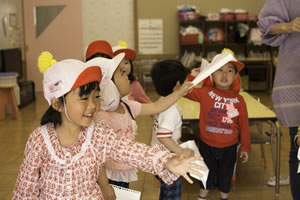
After we left the elementary school, a tsunami engineer from Tokyo University gave us a tour of what was formerly downtown Minami-Sanriku. He showed us the broken flood-gates at the mouth of the river as well as some destroyed bridges. He also showed us a government building whose frame was still standing, but all of the walls and non-metal parts were gone. Even then, some of the I-beams were bent and sheared apart, as if a shipping container shot out of a cannon went through it. While we were at the flood-gates, the tsunami engineer was about to tell us something when the “go home” song (I don’t know its real name) started through the alarm system at 5pm. Everyone waited silently until it was finished. That moment while the song was playing had the greatest impact on me out of the whole trip. We had just been to the nearly destroyed government building and had seen evidence for the power of the tsunami, so we were all very solemn. When the song started playing, it made me realize that Minami-Sanriku was still hopeful of restoring their city, since they were continuing to support the infrastructure of the area by the coast that was totally demolished. Additionally, I thought that the song itself perfectly captured the spirit of Minami-Sanriku. It was perfect for a coastal town, and it flawlessly portrayed the incredible beauty of Minamis-Snriku and the surrounding area. At the same time, it was also so sad when put in context of the tsunami and where we were when we heard it. I am curious whether it was the same song that they played before 3/11. I plan on sending an email to one of the KIP students whose grandparents live in Minami-Sanriku to see if I can find out more about it.
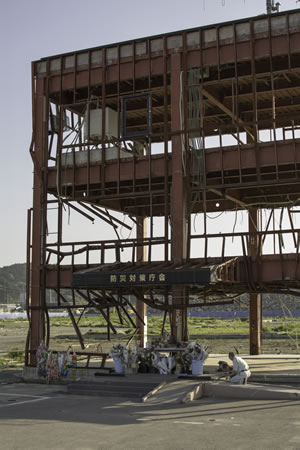
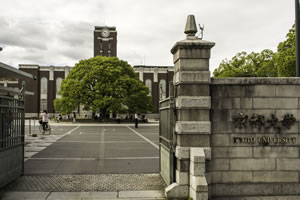
This is the main building of Kyoto University. The large tree in front is hundreds of years old and is used in the seal of the university.
After arriving in Kyoto on Sunday, I met Arikawa-sensei and his fiancée at the station. We went to dinner at a chain restaurant that is famous in Kansai called 551 Horai (“go-go-ichi”). After that, he showed me to my apartment and gave me a map, telling me to be in the lab by noon in time for the group meeting. The next day, I got up early to go to a bakery to get omiyage for my lab mates (I had brought separate omiyage for Arikawa-sensei, Tanaka-sensei, and Yamashita-san from Tokyo and the US). I found the bakery just fine, but according to the map I was supposed to turn at the Circle K kombini in order to get to Kyoto University. Turns out, there are two Circle K’s on the way to the lab, so I got a tad lost after turning at the first one. Once I realized my mistake, I kept going down Shirakawa-dori until I got to the second one. It’s a good thing I decided to leave early that day, otherwise I would have been late for the group meeting. I arrived around 11:30 even though I left around 10:30 (it’s normally a 20-25 minute bike ride).
Arikawa-sensei is my supervisor. He is an assistant professor in Tanaka-sensei’s group. He seems to have a good sense of humor and is very cool. I heard him say “maji de?” when talking with another undergraduate, which is a slang way of saying “seriously?” or “really?” in Japanese. Arikawa-sensei works in the same room/office that most of the masters and doctoral students work in, so he is easy to talk to and very down to earth. Since the office I work in consists of several desks put together, I have many opportunities to chat with my lab-mates. In the lab, too, because we frequently have to share equipment or wait while data is being collected. Everyone will go to lunch at the same time (even Tanaka-sensei will join us occasionally), so I can talk with them then as well.
Everyone in my lab speaks English very well. There are several international students in the lab as well. I sit next to one student who is from Nepal. The first time I met her, I said “hajimemashite” but because of how I pronounced it she thought I said “Namaste”, which is the customary salutation in Nepal used by someone of lower status when they are introducing themselves to someone of higher status. She was very impressed, and after the situation was clarified we all had a laugh. There is also a post-doc from Germany. I don’t think my ability to speak Japanese will affect my ability to work effectively, but I am concerned that because everyone speaks English so well I won’t be able to practice speaking Japanese, so I have to make an effort to enter into conversations in Japanese with my lab mates.
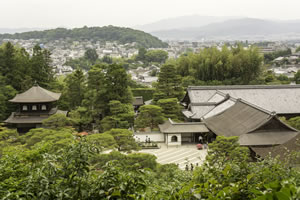
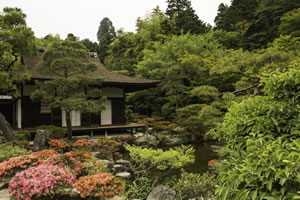
Eastern Kyoto as viewed from the mountainside at Ginkakuji Temple. Ginkakuji Temple (The Silver Temple) is a large and famous temple in Eastern Kyoto and is at the end of the Tetsugaku no Michi (Philosopher’s Walk)
In my research project, I am measuring various aspects of a specific GaAs heterostructure with a QPC that was sent to Kyoto University by Prof. Bird’s lab. There is also a sample that has a TLM on it. I will first measure the current-voltage characteristics of a sample in darkness and ambient lighting, then I will measure the current-voltage characteristics of the sample when it is exposed to a terahertz laser. From there, I can analyze the terahertz-induced current on the sample. I will repeat this procedure for the other sample.
The material I am working with is a GaAs/AlGaAs heterostructure with a QPC that has a 180nm gap. I’m using a Keithley 2400 Sourcemeter and program I developed using the LabVIEW 2012 framework in order to measure the current-voltage characteristics. There is also an ultrafast air plasma terahertz pulse laser. I will be using the sourcemeter and laser to find I-V curve hysteresis on the sample that indicates it will be a good photodetector, and from there I will measure the current-voltage characteristics while it is exposed to terahertz in order to calculate the terahertz-induced current.
Luckily, the vast majority of theory behind my project is classical physics. Although the sample itself still involves quantum mechanics, the I-V characterization I’m doing is classical. I will have to learn how to use the laser in the lab, especially since there are multiple research projects going on that involve it. I also have to learn about some experimental methods such as how to mount the sample in order to expose it to the laser, but those are easy to learn. Based on my current pace and Arikawa-sensei’s suggestions, I believe that I can finish collecting data by the mid-program meeting. After the mid-program meeting, I can focus on theory and analyzing the data, as well as preparing my poster. This still leaves enough time to work with if there are any complications.
Luckily, there haven’t been many major cultural issues for me so far. I’m not sure if this is because I’m good at dealing with cross-cultural barriers or if I just haven’t been observant enough to notice when a critical incident is occurring (hopefully the former). There have been several small things, but they were all related to language barriers and weren’t necessarily “issues”. For example, when Dante, Meagan and Ron were visiting Kyoto, we were looking for a movie theater. A young woman on a bicycle stopped to ask if we needed any help. After she told us where the movie theater was, we started to have a small conversation. At one point, I started speaking Japanese. At this, she looked very surprised and simply said, “Why can you speak Japanese?!”
Another cultural difference I encountered was during our KIP discussion. The topic was whether all students should take liberal arts courses. My group consisted of Makiho-san, Teppei-san, Lila, Ron and myself. One of the main disagreements in our group was regarding students of 2-year colleges. Teppei said that because they don’t have as much time as 4-year university students, they should focus on preparing for their career. I said that they should still have liberal arts courses because it will improve their critical analysis skills. Makiho-san spent many years living in the US, so at one point she noticed that the main reason for our disagreement was because of the differences between liberal arts classes in the US and Japan. It turns out that liberal arts classes in Japan are focused more on discerning your profession whereas in the US they are supposed to help you apply knowledge from multiple spheres in order to better understand a situation or solve problems.
The biggest critical incident for me so far has been when I was at a ramen shop with one of my lab mates, but (fortunately) even this situation wasn’t a big deal. I was meeting one of my lab mates for dinner before we went to Shimogamo shrine for the Hotaru Matsuri, or firefly festival. Unlike the Tokyo Hotaru Matsuri, this one had actual fireflies. Since I mentioned that I liked spicy ramen, we went to a hot ramen shop he knew of. At the end of the meal, my lab-mate went to go pay the bill. I think the cashier asked (in Japanese) if he wanted to pay for us together, to which he responded yes. Since I didn’t want to be treated as a guest, I asked him to please allow me to pay separately, so he told the cashier that we actually wanted to pay separately. I was a slightly awkward moment, but after that we had a lot of fun that night. Since the festival, he has become one of my closest friends in the lab. Looking back on the situation, I realized that he might not have been paying for me as a gift, but rather not to inconvenience the cashier, in which case I would have just paid him back immediately after we left. At the time, I didn’t realize that this may have been a possible scenario, so I interrupted to ask if we could pay separately. I could have just remained calm and paid him back right after we left, taking more time to observe the situation before acting. Even so, I think it is still very unclear whether he intended to pay for my dinner or not. I was so concerned with not being treated as a guest that I immediately concluded that I was being treated as one when instead I should have just been patient and taken more time to observe.
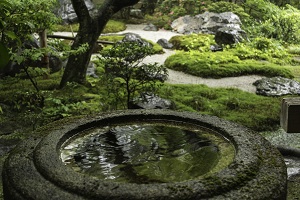
On Saturday I experienced the first real rainstorm in Kyoto. It’s supposed to be the rainy season, but strangely it’s been mostly sunny.
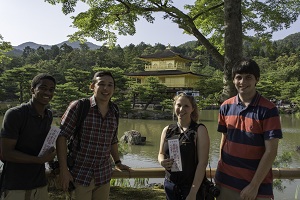
Over the weekend, Dante, Meagan and Ron visited Kyoto. On Sunday we went to Inari and Kinkakuji.
Research Update: This past week, I received an email from Rui, who has been working with the sample in Prof. Bird’s lab prior to my project. He sent me some additional information about the sample, the procedure, as well as the software he used to do IV characteristics. Using his software, I was able to perform another sweep on the sample using the sourcemeter in order to compare his program with my varieties. After that, I managed to use his program to measure IV characteristics with and without a terahertz pulse being applied. The pulse was at a frequency of 80MHz, and each pulse lasted only a few picoseconds. The laser spanned a few terahertz bands. I’ll have to double check this, but I think the laser ranged from 3-30 THz. The power of each pulse was on the micro-watt scale. I used this laser first, as opposed to the high-power, slower laser because this one is closer to the continuous wave laser used by Rui.
Due to the amount of research projects going on in my lab and the limited availability of equipment, everyone in the lab must share the lasers and other equipment. This usually involves someone asking another person who they are sharing the equipment with if it is okay to use X piece of equipment on Y day or time.
It seems that everyone uses ~さんwhen talking to someone who is a year ahead of then, or when talking to Arikawa-sensei. Interestingly, the only other people besides myself who uses ~せんせいis the doctoral student from Nepal and the undergraduate who visits occasionally. Tanaka-sensei and Naka-sensei are always referred to with ~せんせい. Everyone uses ~くん when talking to someone in the same year as them or below them, but only when talking directly to that person, otherwise it will be ~さん。
I haven’t really heard anyone disagree, but once I did disagree slightly with Arikawa-sensei on how we should build the sample-carrier for the TLM sample. I never actually told him I disagreed, I just suggested my idea using a “what-if” scenario, which seems to be a common tactic in the lab. Arikawa-sensei answered with the typical “Yes, but I think it will still be better to… (etc.)” so I accepted his advice and continued with his plan. Later, after doing an experiment, we were discussing the pin configuration for the samples. I pointed out that because of the design of the second sample, we would have to test various combinations of only two of the eleven pins that were present. At that point, Arikawa-sensei realized that my suggestion for how to design the sample-carrier was a little more practical after all, so we ended up going with my idea. I really like this style of communication, it turned out to be much more efficient than it was made out to be in the pre-departure orientation, although still not as efficient as the cut-and-dry American style. The Japanese style also tends to preserve a harmonious atmosphere, so I think it is an excellent method considering that the benefits are much greater than the small amount of efficiency lost. All that is required is to ensure that all parties are aware of each other’s ideas, that way when the situation changes or is understood to a point where one person’s idea is favorable, everyone (ideally) will be able to recognize that idea as the most viable solution.
I remember reading in Kofi’s report about his ordeal with the “holiday” for Founder’s Day at Kyoto University. I laughed to myself when Arikawa-sensei told me two weeks ago that “next Tuesday is Founder’s Day, so you don’t have to come in to the lab that day” because I remember reading about it before I arrived in the lab. Unlike with Kofi, no-one else said anything to me about it. In his report, Kofi said that most people come on the weekends and holidays to work. I’ve talked about this with my lab-mates a little, and it’s not that they are required or even expected to come in on those days, it’s just that they want to finish their research projects as quickly as possible in order to be done with them. (Source: Hikari-Bussei Masters Students) It also has to do with the availability of equipment and having to share with other students. One member of the lab told me that he only comes in on Sunday because no one ever uses the laser then, so he can use it all day. He said that during the week, it’s difficult to find a long enough block of time where he can do what he needs to with the laser system. Also, while talking casually with Arikawa-sensei about the NanoJapan program, I mentioned that I’ll probably be spending the majority of the Tuesdays working on my NanoJapan weekly reports. This is perfect because other students use the Sourcemeter and Laser systems on Tuesday anyway. Because of these two reasons, and that I’ve made excellent progress on my research project, I decided that unlike Kofi I would actually not go into the lab on Founder’s Day but instead stay at my apartment and work on my report. Since I’m only and undergraduate, I think my lab mates would think stranger than otherwise for me to come in on Founder’s Day, especially since my research project isn’t nearly as complicated as theirs are. This seems like a good example of situationalism in Japanese culture.
It’s hard to say based on the short time that I’ve been here, but if I had to pick two things that are highly valued, I would choose producing results and helping the team. When it comes to hard work and long hours, I can definitely see Japanese situationalism come into play. Some members of the lab come in only a few days a week, while other practically live in the lab. As long as you are making good progress on your research and are producing good results, I think that the amount of time you put it is of secondary importance. Also, beyond your own research, it is extremely important to help out the lab. I read an article on LinkedIn once saying that each software engineers should have a separately walled off work space so co-workers wouldn’t be tempted to ask technical questions of each other when they could easily just use Google. The argument was that by asking a question of your co-worker, you are distracting them and breaking their train of thought, and it can take about 15 minutes for them to get back in “the zone” after being interrupted like that. Conversely, everyone’s desks in my lab are organized in such a way that encourages discussion among the lab members. No one hesitates to ask someone for help or to talk with them about anything.
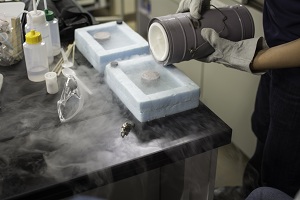
At the lab down the hall, some students gave a demonstration of the superconductor they have been researching. This was part of the Lorentz Festival, which was essentially an open house of the Kyoto University Graduate School of Physics for undergraduates.
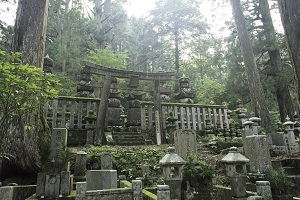
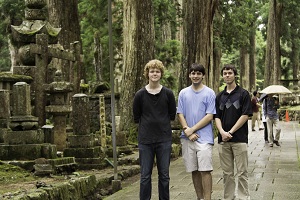
Over the weekend, I went to Koyasan with JJ and Jordan. Okunoin was one of the coolest things I have experienced in Japan so far.
Research Update: Over the past week, I have measured the THz response for the first sample and obtained a higher accuracy IV curve for the same sample where the hysteresis occurs. At this point, I don’t think I will be able to do anything with the second sample before the mid-program meeting. Early last week I was having problems with the sourcemeter, but it has been resolved.
I think my biggest personal accomplishment to this point has been how much my Japanese skills have improved. I’ve recently been trying to study more grammar and vocabulary, so I’ve been focusing on the things that I still need to learn. Because of that, it seems that I’ve lost sight of how much I already know. During Kono-sensei’s visit to my lab, I heard him speaking to Arikawa-sensei in Japanese. When I found that I could understand 98% of what they were saying, I realized just how much I have improved since the beginning of the summer. People in my lab sometime comment on how well I can speak Japanese, but I thought they were just being polite. Still though, there is a lot I don’t understand yet.
Similarly, studying Japanese has also been my biggest personal challenge to this point. The same day as Kono-sensei’s visit, a newspaper salesman knocked on the door of my apartment. Although I could understand many of the words and phrases he used, I still could not understand the overall meaning of his sentences.
My research is going well. This week and immediately following the mid-program meeting, I have a series of experiments planned to help determine whether or not the Gunn Effect truly is responsible for the THz photosensitivity of the sample, as well as to obtain a rough estimate of the NEP of the sensor. At this point, I am uncertain that I will have time to obtain any meaningful data from the second sample. This is partially because we don’t completely understand what is happening with the first yet. After the experiments mentioned above, I think about possible mechanisms for how the THz beam triggers the Gunn Effect (unless Prof. Bird already knows) and perhaps design an experiment to test our conjectures.
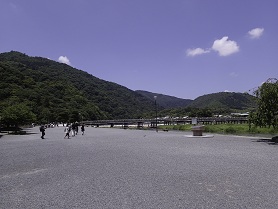
Over the weekend, I went to a town west of Kyoto with a few of my lab-mates to eat at an authentic unagi restaurant.
Research Update: Over the past week I measured the THz response of the sample with a more accurate sweep in the 5-17V range, and I measured the THz polarization dependence.
No report submitted.
In my lab, there is another student that is using the sourcemeter in his research, so we have to coordinate our experiments. The week before the mid-program meeting in Okinawa, I asked him what days he was planning on using the sourcemeter. He said, “I want to use [it] Friday, or Thursday.” I said that I wanted to use it on Wednesday, but I also asked that in case I couldn’t finish my experiment on Wednesday, if I could use it on Thursday as well. I explained that I wouldn’t be in Kyoto on Friday, so he would be able to use the sourcemeter for all of Friday. When he didn’t respons, I said, “Actually, I think that I will probably be able to finish all of my experiment on Wednesday, so I probably won’t need to use it on Thursday.” After that, he started laughing but still didn’t respond. I told him that I was sure that I could finish on Wednesday and that I wouldn’t need to use the sourcemeter for the rest of the week.
The main “good intention” behind the actions in this scenario was to preserve a friendly relationship, and we both wanted to be supportive of each other’s research. I first realized that there was a misunderstanding when I saw the expression and reaction of my lab-mate when suggested that we switch Thursday and Friday. I originally thought that when he said “Friday, or Thursday” he meant that either Friday or Thursday was fine. After I saw his reaction, I realized fairly quickly that what he really meant was “Friday. Or [on second thought], Thursday.” After I realized that, the situation resolved itself fairly quickly. I simply said that I actually would only need to use the sourcemeter on Wednesday.
Next time, I would think for maybe a second longer about the effect that the location of the comma has in the sentences of my lab-mates, and also the various meaning that conjunctions like “or” have.
Photos: This past week has been an EXCELLENT week for photography. As of now I’m fairly certain that I’ll be using one of the photos from Itsukushima Shrine in Hiroshima for my canvas photo, probably either the crane one or one that shows the whole shrine. I’ve attached two of these photos below.
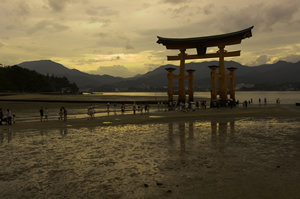
Sunset at Itsukushima Shrine in Hiroshima prefecture.
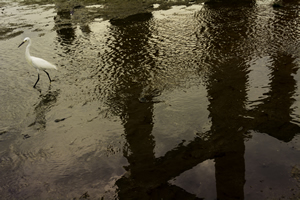
The crane is considered to be sacred in Japan. The crane pictured here has just waked through the large tori gate on the coast at Itsukushima, which you can see through a reflection in the water.
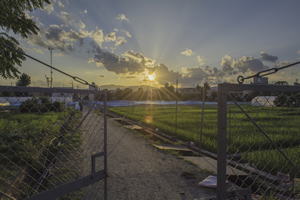
The Kyoto University Graduate School of Agriculture’s rice fields are directly across from the building my lab is in. As I was going home one day, I noticed how vivid the sun’s rays were as it was setting. I think this photo does an excellent job capturing Kyoto’s historic natural beauty.
Research Update: I measured the power-dependence for the sample again, this time at half power, one tenth power, and one twentieth power in addition to full power, at a polarization of 135 degrees. The results were slightly confusing, as you can see from the graphs, which I will include in a separate email. I also measured the IV curve of the sample without any THz both before AND after the THz measurements. I expected them to be exactly the same, however they were not.
The most current results call for additional experiments, however I won’t have time for these. Today I plan to measure the IV several times without the THz to see the consistency of the baseline IV curve. Other than that, I won’t be able to do any more. Because of this, I may have to focus on presenting the sensitivity of the sample to the low power of THz delivered by the Ti:Sapphire system and the earlier power dependence experiment in my poster. I will also try to estimate the NEP today, and perhaps I can include that as well.
For this week’s report, I interviewed my mentor, Professor Takashi Arikawa. He is an Assistant Professor in the Tanaka Lab.
What are your degrees?
PhD 2009 in science from Hikari Bussei (The Tanaka Lab at Kyoto University), masters 2006 from Kyoto University, Post-Doc at Rice from 2009-2011.
Why did you decide to study these fields?
Major was Physics. When I was Junior, did first optics experiment. I thought it was very interesting so chose Tanaka lab. The experiment explored phase of light wave. I first realized how important phase of light is. Eyes cannot detect phases of light wave, but it still has very many useful effects and applications. The experiment detected the phase of light.
What was it like to be a student in Japan?
In Japanese University, undergrads mainly take classes and study theoretical things, but they don’t have much opportunity to do lab work. He thinks in the US there are more opportunities to do labs. For experimental physicists, he thinks that is a big difference and is very important. Japanese undergrads wouldn’t know experimental methods or how to use LabView because of the lack of lab courses at the undergraduate level.
Describe your career path.
I have only been a researcher.
Hikari Bussei has very typical/traditional lab structure: Professor (Principle Investigator), Associate Prof, Assistant Prof. His goal to be head professor but he will probably have to go to another University to have his own research group. In the US, he thinks it is more common for an assistant professor have their own group. In Japan, assistant professors work in Head Professor’s lab. In the US, young researchers already have independence.
Labs: How is research funded in the US and Japan?
US: probably mostly by NSF and maybe other government organization like DoD, also private corporations.
Japan: Similar to US. Organization like NSF called JSPS (Japan Society for the Promotion of Science). Mostly, if not all from Japanese Government.
How do you think that a lab in Japan differs from the US?
For graduate students, the biggest difference is money. Most graduate students in US hired by professors. In Japan, graduate students must pay full tuition. There is a very limited number of jobs for graduate students and the salary may be much lower. As far as research goes, no big differences. Thinks research is now global.
Communication between students and professors in Japan may be difficult because traditional professors are mostly not very friendly towards students. (Although Tanaka-sensei is very friendly). In the US, maybe students can tell their opinion to professors regarding research or other topics. In Japan this is very uncommon, but recently it’s becoming easier for students to talk with professors. Although, it really depends on the professors.
Some professors ask students for research updates every day, while others will have update once a month, which is a very different experience for students. For strict professors, students will have to present every day, but this is in any country as it only depends on the professor.
International: What is your international experience?
Very fun, very fruitful. His post-doc in the US was first time to leave Japan. Everything was new for him. Very lucky to have opportunity to be in Kono-sensei’s group at Rice University.
How many international researchers work in your lab?
Many researchers visit this lab/group to help with research or present for a short amount of time. Sandayah-san from Nepal and Christian-san from Germany are currently the only long-term researchers in the lab. However, the lab is typically very international. There are many research collaborators of Tanaka-sensei that will send students or researchers to this lab for short periods of time to do research. There’s always at least one international student in this group.
How has the internationalization of research impacted your work?
When he started doing research, the research field was already international. Compared to other professors, he was very young. Has had experience working in an international settings since he first began to do research. When he was a senior in undergraduate, he started reading English textbooks to prepare for working in an international setting. Other than that, no preparation for working in an international environment. Also practice by reading journal articles about physics that were published in English.
What advice do you have for someone preparing for a career in research?
Research field is already international. For Japanese students, if they cannot speak English than the research field will be confined to a very small community in Japan. He recommends Japanese students to study abroad in order to expand ability to work internationally. A post-doc is maybe first opportunity to go abroad, but it is a very good opportunity that Japanese students should take advantage of.
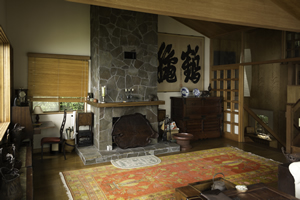
Atami Home: Packard-sensei invited a few NanoJapan students to her vacation home in Atami in order to see the Atami Hanabi Taikai (famous fireworks display) and to interview for KIP.
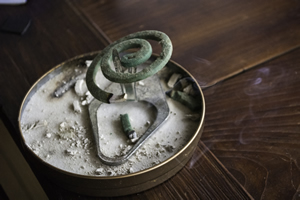
Killer Incense: You can always tell it’s summer in Japan because these little insect-repelling incense coils start to pop up everywhere.
Research Update: I’ve wrapped up my project by completing one last power-dependence experiment and by calculating and estimate for the NEP of sample 1. I’ve also completed a draft of my poster and submitted my abstract.